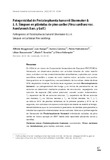| dc.rights.license | http://creativecommons.org/licenses/by-nc-sa/3.0/ve/ | |
| dc.contributor.author | Maggiorani, Alfredo | |
| dc.contributor.author | Rangel, Luis | |
| dc.contributor.author | Cadenas, Aurora | |
| dc.contributor.author | Pietrantonio, Pietro | |
| dc.contributor.author | Bracamonte, Lilian | |
| dc.contributor.author | Rondón Sulbaran, Maria Teresa | |
| dc.contributor.author | Holmquist, Otón | |
| dc.date.accessioned | 2011-06-22T20:08:10Z | |
| dc.date.available | 2011-06-22T20:08:10Z | |
| dc.date.issued | 2011-06-22T20:08:10Z | |
| dc.identifier.issn | 0798-2437 | es_VE |
| dc.identifier.uri | http://www.saber.ula.ve/handle/123456789/33376 | |
| dc.description.abstract | En 2004 en un vivero de Corporación Venezolana de Guayana-PROFORCA,
Venezuela, se observaron plantas con acículas basales de color marrón
claro, acículas con las zonas intermedias amarillentas y apicales con zonas
marchitas amarillas y zonas de color marrón rojizo, acículas con puntos
blanquecinos en la superficie y oscurecimiento de las raíces, detectándose
30% de plantas muertas. De todas esas regiones, se aisló Pestalosphaeria
hansenii. La patogenicidad del hongo y su forma de penetración en las
acículas se determinó mediante pruebas de inoculación, asperjando una
solución de esporas (SE) sobre plántulas, usando cuatro tratamientos:
T1- aspersión de SE en acículas intactas; T2- aspersión de SE en acículas
con heridas; T3- no SE/con heridas y T4- no SE/sin heridas. En T1 y T2
se obtuvo 94% de plantas enfermas en la primera prueba y 81% en la
segunda, con acículas con ápices color rojizo de donde se reaisló el hongo,
determinándose que no se necesita la presencia de heridas para penetrar e
infectar los espacios intercelulares de las acículas. Este es el primer reporte
en Venezuela de Pestalosphaeria hansenii infectando acículas de pino
caribe en vivero aunque en 2001 había sido reportado atacando conos y
semillas. | es_VE |
| dc.language.iso | es | es_VE |
| dc.rights | info:eu-repo/semantics/openAccess | |
| dc.subject | Pestalosphaeria hansenii | es_VE |
| dc.subject | Ascomiceto | es_VE |
| dc.subject | Pinus caribaea var. hondurensis | es_VE |
| dc.subject | Pino caribe | es_VE |
| dc.subject | Acículas | es_VE |
| dc.subject | Vivero | es_VE |
| dc.title | Patogenicidad de Pestalosphaeria hansenni Shoemaker & J. A. Simpson en plántulas de pino caribe (Pinus caribaea var. hondurensis Barr. y Golf.) | es_VE |
| dc.title.alternative | Pathogenesis of Pestalosphaeria hansenii Shoemaker & J. A. Simpson on Caribbean Pine seedling | es_VE |
| dc.type | info:eu-repo/semantics/article | |
| dc.description.abstract1 | In 2004, at a nursery of CVG Proforca, Monagas state, a disease appeared
with the following symptoms, from where Pestalosphaeria hansenii
was isolated: basal needle bundles light brown, or with the medium ones
yellowish, or with the apical ones with yellowish wilted zones and zones of
reddish brown color, needle bundles with whitish points on the surface and
blackening of roots, detecting 30% of dead plants. The fungus pathogenecity
and its way of penetrating into the needle bundles were determined by two
inoculating tests, spraying a spore solution (ES) on needle bundles of plants
of caribbean pine produced in Mérida city, using four treatments (T): T1 –
spraying of ES on intact needle bundles; T2: spraying of ES on wounded
needle bundles; T3: no ES/ without wounds and T4: no ES/with wounds.
It was obtained in T1 and T2, 94% (average) of diseased plants in the first
test and 81% in the second one, with needle bundles with reddish tips,
from where the fungus, that does not need entry doors to penetrate and
infect needle bundles intercellular spaces, was re-isolated. This is the first
report for Venezuela of P. hansenii infecting needle bundles of caribbean
pine plants at the nursery. | es_VE |
| dc.description.colacion | 67-76 | es_VE |
| dc.description.email | kdnasaurora@yahoo.com | es_VE |
| dc.description.email | pietropm@ula.ve | es_VE |
| dc.description.email | bracamon@ula.ve | es_VE |
| dc.description.email | mariat@ula.ve | es_VE |
| dc.description.email | holmquis@ula.ve | es_VE |
| dc.description.frecuencia | semestral | es_VE |
| dc.identifier.depositolegal | 198102ME433 | es_VE |
| dc.subject.facultad | Facultad de Ciencias Forestales y Ambientales | es_VE |
| dc.subject.institutoinvestigacion | Instituto Forestal LatinoAmericano (IFLA) | es_VE |
| dc.subject.keywords | Ascomycete | es_VE |
| dc.subject.keywords | Caribbean pine | es_VE |
| dc.subject.keywords | Nursery | es_VE |
| dc.subject.publicacionelectronica | Revista Forestal Latinoamericana | es_VE |
| dc.subject.seccion | Revista Forestal Latinoamericana: Artículos | es_VE |
| dc.subject.thematiccategory | Geografía | es_VE |
| dc.subject.thematiccategory | Medio Ambiente | es_VE |
| dc.subject.tipo | Revistas | es_VE |
| dc.type.media | Texto | es_VE |


